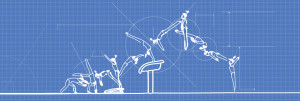 Day 4 – Rings and Vault and Parallel Bars
Day 4 – Rings and Vault and Parallel Bars
..or  how not to get hit in the face by rings while spotting.
We started with the familiar review of biomechanics a great way to start the day by the way, you should really try talking about spring actions and ground forces during breakfast it’s great 🙂 Our skill of the day on rings was press to handstand which we work on with the girls on the floor and it’s challenging, I was amazed at how the boys were able to control the rings enough to complete the progressions, never mind to do a free press without spot. We reviewed some of the basics of rings control none of which I was familiar with apart from when I have done ring dips at home and realized that it’s easier to brace yourself against the ring with your forearm which of course is cheating in the real world. We also touched on the notion that any conditioning that you do should be counterbalanced with conditioning for the antagonist group of muscles. In other words if you are doing shoulder work for the front of the shoulders be sure that you incorporate some rear shoulder work to balance the load and the work. This should go some way towards eliminating unbalanced development physically and the widening of strength gaps that tend to develop.
Ring specific mechanics for the handstand were covered including some drills and some spotting by controlling the rings while the handstand in in place but also swinging up to handstand and pressing to handstand. The thing about rings is the actual ring control since the athlete should already have the basics and in fact the advanced handstand skills before trying it on rings. We saw some demonstrations of higher level ring moves but the spot was restricted to press to handstand and swings. The swings are lethal, if you are head height with the rings during swings you are likely to get smashed in the face by the rings since they tend to move side to side as well as in and out which isn’t necessarily expected.
Vault, I thought we would be spotting vault a lot more than we did but instead we spent time working on double back timers and working towards the double back spot into the pit. We did talk about the run and the importance of velocity in the vault. Basically you can correct anything except lack of speed. We talked about early blocking, hands out blocking, Tsukahara drills and Yurchenko drills on both the vault table and the fast track. We covered twisting off the vault and the easy way to rotate the arm down and then back up for full twist. Sadly though we didn’t get the chance to spot Tsuks which would have been nice however we did enough work on progressions that spotting should be a formality but the time they try the skill.
A couple of interesting things to note. As the athlete becomes better at vaulting, the handspring vault becomes less of a benefit and more of a hinderance. Once advanced vaults are learned, the handspring should basically not be used at all. Teaching twisting off vault starts on the tramp, this emphasizes a late twist since the back drop position is already the boundary between quadrant 3 and 4. However the low risk and plentiful rotation time gives great assistance to the start of the rotation for beginners. For teaching both front and back tucks from vaults you can use resi to vault up to and then do the tuck off the rest to start teaching the tied in rotation. This can work for both FHS Full and yurchenko full. You could also use an angled resi to roll out of to reinforce the rotation after the handspring to connect the two pieces.
Tsukahara was covered a little which is good because we do have kids performing this vault. The progressions through the fast track to the table were good but mostly stuff we are already doing at our gym which was great to see.
Parallel Bars was more familiar after doing cast to HS on the women’s bar you get used to the swing spotting techniques. We covered swings and giants including some very interesting drills that basically ended up with the athlete swinging into a red mat face first. Boys gymnastics… gotta love it!
The interesting point about PBars for women is that it’s a transferable skill and there are things that can be trained without the hip bashing that comes with the low bar. This can allow for greater rep training and better efficiency of time once the female athlete gets used to the pendulum motion of the swing. As an aside, this also speaks a little to development of shoulder flexion for women and a benefit of the swing being the repetitive strengthening of the back support position.
Specifically for the men we covered the Diamadov, Stutz and the Felge to handstand. The twisting components here can be trained using blocks outside the frame of the PBars to rotate out to which I found innovative.